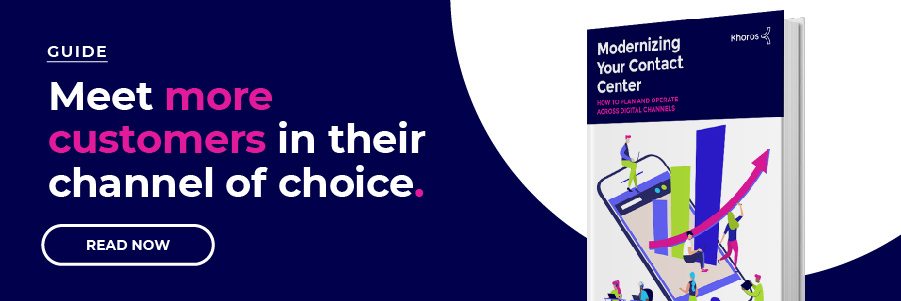 Logo
Logo
EXPERT INSIGHTS
May-11-2022
Contact center best practices for 2022
Introduction
A survey of over 1,000 American consumers found that 74% of people believe contacting customer support is a frustrating experience. Reaching out to a contact center can be so frustrating that:
44% of customers would rather clean a bathroom
25% would rather sit in traffic
24% would rather do their taxes
Even though poor experiences have created a negative perception of contact centers among consumers, brands can right the ship by doing exactly what competitors struggle with: delivering a great experience when customers reach out to their contact center.
To help improve your customer support and provide a great experience, we created this guide of best practices and tips for specific industries you can implement in your contact center.
Learn what a contact center is, how it’s different from a call center, important metrics for contact centers to track, and best practices to improve the quality and efficiency of your contact center for 2023 and beyond.
What is a contact center?
A contact center is a business department responsible for managing customer inquiries and interactions across all channels, both digital and non-digital. This includes providing support through phone, email, chat, SMS, social media, and more.
The goal of a contact center is to meet customers where they prefer to interact. In some cases, this may involve moving between channels. For example, a customer may send an email request in the morning but wish to continue the interaction over the phone or social media later in the day. A digital contact center should provide a seamless experience so customers don’t have to repeat themselves each time they engage with the brand.
We found that 62% of consumers want to be able to engage with brands across several digital channels, and 77% of consumers want brands’ internal teams to communicate so the customer doesn’t have to repeat themselves. This is a major challenge, as over three-quarters of brands struggled to create a cohesive journey across channels and devices.
Contact center vs. call center
The terms “contact center” and “call center” are often used interchangeably but differ. Call centers are much more limited than contact centers, as they only manage customer interactions over the phone. Contact centers are broader in scope, as they manage inquiries through all channels. For this reason, the customer engagement and service industries have realized that traditional call centers are outdated. Modern businesses are expanding their support options to create better, more fluid customer experiences — and in most cases, this means ditching the call center in favor of the much more flexible and efficient contact center.
Contact center metrics
Management teams should determine which metrics they want to monitor in a contact center (many of which will still be similar to traditional call center metrics). Here are a few essential KPIs that many brands use, though you should create custom goals tailored to your brand:
Response time: Average time it takes to respond to a customer inquiry
Abandonment rate: Percentage of customers who end their inquiry before a resolution is reached
Average handle time: Average amount of time spent resolving each inquiry
Resolution rate: The rate at which your brand resolves customer inquiries
Customer satisfaction: Measure of whether a customer was satisfied with their contact center experience and to what degree (this may involve several customer experience metrics such as CSAT, NPS, and CES)
Contact center best practices
Now that we know where to look to track success, here are some contact center best practices to help you deliver great service and an exceptional experience for your customers:
Hire the right customer service agents & train them well
Define employee roles
Set goals and monitor KPIs
Provide incentives for better performance
Invest in technology for your contact center
Identify opportunities for customer self-service
Create an escalation chain
Manage workflow to meet demand
Collect feedback from customers after every interaction
Centralize all contact center data
Have secure channels for sensitive information
Continue to improve
1. Hire the right customer service agents and train them well
Your agents are customer-facing representatives for your brand, so put time and resources into hiring candidates who align with your brand values and have the right skills — both tangible and intangible. Not all of the important people skills that come with agent job descriptions can be taught, so contact center managers should take the time to screen potential candidates thoroughly. Of course, even those with a natural ability for customer service should be trained well to ensure they’re adequately prepared before handling customer inquiries on their own.
2. Define employee roles
Clearly defining roles in a contact center is crucial for improving clarity, accountability, efficiency, productivity, customer satisfaction, and employee retention. By outlining job responsibilities, setting performance expectations, and establishing clear communication channels, contact center employees can better understand their role within the organization and what is expected of them. This increases job satisfaction, better performance, and improved customer service.
3. Set goals and monitor KPIs
Your brand should identify important metrics relevant to its contact center, then establish goals to track progress over time. For example, your brand may aim to improve the contact center’s average response time from one hour to 45 minutes by the end of the year. Doing this helps you break down long-term goals into achievable steps, such as reducing the average response time by 5 minutes each month until the desired outcome is reached. Furthermore, contact center metrics will help you determine what’s going well and what needs greater focus.
4. Provide incentives for better performance
Once you track those KPIs, incentivizing these goals for your contact center employees will motivate better performance and help achieve business objectives. Again, the performance metrics that incentives are based on vary depending on the organization's goals and priorities, but commonly used KPIs include customer satisfaction ratings, resolution rate, average handle time, and quality scores. Incentives can be bonuses, recognition programs, or career advancement opportunities and should be tied to specific metrics to motivate employees to perform at their best.
5. Invest in technology for your contact center
Investing in the right technology is one of the best ways to improve contact center effectiveness and efficiency. As the world moves away from call centers and into digital-first customer engagement, brands need a contact center solution built with digital service in mind.
Modernizing your contact center can improve satisfaction and dramatically reduce support costs.

Increase customer satisfaction by connecting your channels to one platform with omnichannel support. Additionally, automated workflows reduce response times and costs by increasing agent efficiency. For example, implementing self-service solutions like AI-chatbots and online communities can help deflect call volume by enabling customers to resolve inquiries independently. Doing so allows agents to spend less time answering the same questions and more time providing care for people with unique inquiries. Beyond giving agents more time, the right contact center technology can also help them work more effectively by leveraging AI-powered assistants that analyze customer sentiment and provide suggested responses. This removes the need for scripts or long lists of questions that most call centers rely on, and customers don’t like.
These are just a few ways a digital-first contact center can help your business. Request a demo of our software to learn more and see for yourself.

6. Identify opportunities for customer self-service
Agents may spend a large portion of time repeatedly answering the same common questions, which limits their efficiency. A McKinsey report found one company had 2,000 reasons for customers to contact their contact center, but just sixty of those inquiries accounted for 65% of the total volume. This is exactly where an AI chatbot or online community can help. With these solutions, brands can empower their customers to find answers to their questions and issues, improving customer satisfaction and agent efficiency simultaneously.
In one example, Khoros customer Schneider Electric used its online community of 20,000 unique monthly visitors to resolve 90% of questions in less than 24 hours.

This benefits customers and agents, as customers get answers quickly, and agents don’t get bogged down by repetitive inquiries.
7. Create an escalation chain
Some cases may warrant a customer speaking with a supervisor instead of an agent, such as when the agent doesn’t have an answer or if the customer is deemed a VIP based on their account size or influence. Establishing an escalation chain for these scenarios is important so agents know when to hand customers off to someone else and who that person should be. This ties into what we mentioned earlier about clearly defining roles — this will lay the foundation for an escalation chain.
8. Manage workflow to meet demand
Contact center managers should continuously monitor volume to ensure agents don’t get overwhelmed during spikes, which can lead to long response times and upset customers. For example, during the holiday season, support volume requests often increase by as much as 65%. Monitoring volume to anticipate these spikes can help contact centers prepare and respond before the customer experience gets negatively affected.
9. Collect feedback from customers after every interaction
Another advantage modern contact centers have over traditional call centers is feedback gathering. Collecting customer feedback after each support interaction is essential for gauging satisfaction with your contact center. Furthermore, collecting feedback shows customers you value their opinions and are actively listening to find opportunities for improvement.
However, brands must ensure they’re collecting both solicited and unsolicited feedback. Solicited feedback from surveys has value but doesn’t give the full picture of the customer experience and usually is concentrated around the extremes (sometimes positive but often negative). To get unsolicited feedback, you’ll need to utilize social listening to analyze what customers are saying on social media, online forums, and in reviews.

10. Centralize all contact center data
On that note, centralizing all contact center data is crucial in today's business environment. With the vast amount of information generated by modern contact centers, it’s important to have a centralized database that can store, organize, and analyze all this information. This can help contact centers gain valuable insights into customer behavior, agent performance, and overall contact center effectiveness. By having access to this data in one place, contact centers can make more informed decisions, improve customer experience, and optimize operational efficiency.
11. Have secure channels for sensitive information
In the digital age, many companies handle financial or private information. This is why it’s crucial for all of your channels that receive this data (email, phone call, form submission, chatbot, etc.) to be secure. This also applies to the flexibility of channels — for example, customers may be uncomfortable sharing personal information over the phone where it can be overheard by others, so brands should ensure their contact centers offer the ability to discuss details over other channels.
Secure forms can be a huge advantage for brands who want to keep customer information safe without adding unnecessary customer effort. Alternatively, some customers may prefer to take advantage of self-service solutions so they never have to share this sensitive information with another person in the first place.
12. Continue to improve
Finally, one of the most important best practices for modern contact centers is to continuously strive for improvement. This includes regularly reviewing and refining processes, embracing new technologies and best practices, and investing in employee development and training. By focusing on continuous improvement, contact centers can stay ahead of the competition, meet evolving customer needs, and drive better business results.
Industry-specific contact center best practices
Beyond the general contact center best practices above, we’ve also outlined some guidance for specific industries:
Financial services & insurance: These industries often deal with sensitive personal and financial information, so contact centers need to be equipped to deal with heightened security and compliance concerns. Contact center agents should be well-versed in financial regulations and products, and be able to quickly and accurately address customer concerns.
Telecommunications: Outages and issues can result in customers who are unable to communicate with others, do their job, or enjoy home entertainment. Furthermore, customers may be limited in the way they can reach out to contact centers. Because of these limitations, companies should have plenty of channels for users to get in touch.
Technology & software: Enterprise technology and software brands understand and commonly use AI, ML, and automation in their products and services. To create a more unified ecosystem of support, these companies should also integrate these tools into their contact centers to enhance customer care and provide 24/7 assistance.
Travel & hospitality: These brands often get influxes of high-stress and time-sensitive inquiries, such as customers needing a last-minute flight or hotel booking. In these scenarios, failure to respond quickly can lead customers to seek an alternative solution from a competitor. Because of this, the goal should be personalized service and exceptional customer experiences at all costs.
Retail & distribution: High volumes of inquiries related to order information, shipping status, and returns are commonplace here. While these requests are often simple, their quantity can take up a significant amount of agent resources. To prevent this from happening, brands in these industries should utilize AI to automate the resolution of these inquiries so agents can focus on more complex questions.
Improve your contact center effectiveness
Best practices are a good start, but not the end of improvement. If you’re looking for a way to maximize the efficiency and effectiveness of your contact center, Khoros can help. Our enterprise contact center software helps businesses transform their contact centers for the digital age and take their customer support to the next level, enabling them to create more meaningful connections with their customers and drive long-term loyalty.
This is a game-changer for businesses looking to improve their contact center effectiveness. Its powerful suite of features includes AI-powered chatbots, rich analytics, and seamless omnichannel communication. These work together to streamline operations, deflect call volume, reduce response times, and deliver exceptional customer experiences. To learn how, contact us for a demo today.











